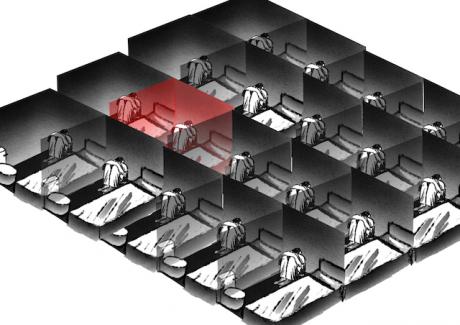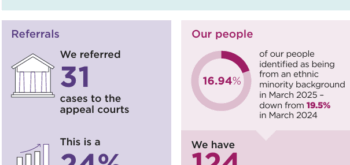[contextly_auto_sidebar id=”O9imnUX4GO4h1KR8vmL54pimKvlqpx2o”]
“They look at you like you’re a dog, making you strip is bang out of order.” The final shocking extract from Children Behind Bars. You can read the other two instalments here and here.
At Teesside Crown Court in May 2013 a man called John Cornwell was found guilty of four charges of sexual assault of children, four charges of indecent assault of children, and two charges of engaging in sexual activity in the presence of a child. The offences dated back to the 1990s.
Sentencing Cornwell to six years’ imprisonment, the judge said: “It is quite clear from the victims’ statements that untold misery has been caused. The effect will no doubt remain in their minds.”
 After his conviction, Cornwell, aged 53, was sacked from his job. He was a support worker at Northallerton young offender institution in North Yorkshire a prison that had detained children until 1998.
After his conviction, Cornwell, aged 53, was sacked from his job. He was a support worker at Northallerton young offender institution in North Yorkshire a prison that had detained children until 1998.
How might a man so thoroughly unsuitable have been employed by the prison service for so long? Was John Cornwell a one-off?
For some years now I have been trying to gather information on prison officers and governors who have been convicted of sexual offences. Knowing the risks of closed institutions, and the opportunities for abuse inherent in prison culture, I wanted to find out who among them had worked with locked up children. I asked the Ministry of Justice. My enquiries were not productive. Data protection exclusions in the Freedom of Information (FOI) Act 2000 stopped me from finding out the names of prisons in which convicted sex offenders had worked prior to conviction.
Officers frequently transfer between prisons as their career progresses, and cross-deployment on split sites is common. It is reasonable to assume that many (if not all) of the following individuals worked at least some of the time with child prisoners.
 John Maber had been a prison officer for 18 years when the Crown Prosecution Service announced in July 2012 that he had been handed a life sentence “after pleading guilty to 27 offences of child sexual abuse including the rape of a baby girl aged just four months”.
John Maber had been a prison officer for 18 years when the Crown Prosecution Service announced in July 2012 that he had been handed a life sentence “after pleading guilty to 27 offences of child sexual abuse including the rape of a baby girl aged just four months”.
The police investigation found he was at the centre of a paedophile ring. After evidence was found on his laptop, hard drive and mobile phone, 15 more arrests were made.
At the time of his arrest, Maber was a senior officer at the adult prison Pentonville.
Acting prison governor Russell Thorne was jailed in July 2011 for five years for misconduct in a public office between 2006 and 2010 after coercing a young prisoner to engage in sexual acts with him at Downview women’s prison in Surrey.
Allegations of sexual abuse were made about other prison officers at Downview, which had a dedicated unit for girls, and a prison service review was established in 2012.
Surrey police established a special investigation, called Operation Daimler. More than 200 past and present prisoners were interviewed. I asked the force how many girls were seen during this investigation and was appalled to learn that not a single child was interviewed.
After being instructed by the Information Commissioner to release the information, the Ministry of Justice confirmed in May 2014 that four officers working at Downview prison had been suspended, dismissed or convicted between January 2009 and October 2013 “as a result of a sexually inappropriate behaviour with women prisoners or a young offender”.
This was seven months after a request was first lodged for separate data on the number of prison officers disciplined or convicted as a result of sexually inappropriate behavior with women prisoners and with girls in this Surrey prison. The oblique language avoids public acknowledgement of child sexual abuse (whether there is private recognition is impossible to assess).
The Information Commissioner did not support disclosure of the report from the internal prison service investigation, stating it “could potentially cause unnecessary and unjustified distress” to the prison officers discussed within it. The report remains buried.
A separate FOI request I made to Surrey County Council revealed that “less than 10” girls in Downview prison made sexual abuse allegations against staff in the five years to March 2013. I was told that these, and other allegations from girls, were either investigated internally by the prison, or no further action was taken.
Had a statutory child protection investigation been undertaken by the local authority following any of the sexual abuse referrals, one obvious consideration would have been the role of strip-searching in facilitating abuse.
It is hard to imagine children more vulnerable than those in prison. These are children who have suffered enormous deprivations and grave violations in their early lives, many disabled and/or formerly looked after by local authorities, locked up tens and hundreds of miles away from home.
The ordinary practices of penal institutions feature in past institutional child abuse investigations. Removal of children’s clothes, the infliction of pain as restraint, petty rules and summary justice, as well as denial of fresh air and punishments for making complaints – all these, and more, are part of the murky history of children’s homes run by the state, religious bodies and the large children’s charities.
Take a look at the inquiries more than 20 years ago into the abuse of children in care in Leicestershire and Staffordshire for the stark parallels with penal custody today. Children then were also deeply aware that they were society’s undesirables and unlikely to be believed if they ever reported abuse. Regimes were tolerated because they were seen to be successful in controlling wayward children.
The power that officers wield is immense. Until very recently, thousands of children entering and leaving young offender institutions every year were systematically forced to take off their underwear and endure additional ‘random’ searches. The former head of the Youth Justice Board, John Drew, told me that when strip-searching was rife, the implicit message to children was: “You’re mine, I can do anything I like with you.”
Risk assessments as a pre-requisite of strip-searching have been required only very recently — since 2011 in secure training centres and since 2014 in young offender institutions. Only close monitoring could determine whether such assessments are being properly carried out.
Under any circumstances, being strip-searched is a demeaning experience. At its least ugly, children are made to stand in front of officers, exposing the top and then the bottom half of their naked bodies, while handing over their underwear for inspection.
It gets worse than that. During autumn 2013, prisons inspectors uncovered “at least four incidents of young people being strip-searched under restraint and not as a last resort” in Werrington young offender institution. That inspection report recommends the cessation of strip-searching under restraint, although it fails to question the legality of the officers’ actions. [PDF here]
In 2005, as a member of the expert panel of Lord Carlile’s independent inquiry into the use of physical restraint, solitary confinement and forcible strip-searching of children in penal custody, I encouraged child prisoners to talk about their experiences of being strip-searched. One 16-year-old girl told me: “For people who’ve been abused it’s not very nice.”
Another 16-year-old girl in a different secure training centre told me: “The more you do, the less embarrassing it gets.”
She was to be released in two weeks’ time and wondered if she should ask for one of the six staff who had already seen her naked to undertake her final strip-search: “I could ask for one of them. It’s not nice for the whole centre to see you in the nude.”
 At Durham Crown Court in June 2011 prison governor Barry Cummings was given a four-year custodial sentence after being convicted of three charges of sexually touching a girl under the age of 13 some years previously.
At Durham Crown Court in June 2011 prison governor Barry Cummings was given a four-year custodial sentence after being convicted of three charges of sexually touching a girl under the age of 13 some years previously.
Cummings had worked at Low Newton prison, which formerly detained children, and at prison establishments around the North-East.
At Newcastle-upon-Tyne Crown Court in May 2011 retired prison officer Christopher Pearce was given a 12-year custodial sentence for raping and indecently assaulting a young girl over a period of five to six years.
The child was six when Pearce first began indecently assaulting her, and 10 when he started raping her. The court heard Pearce had raped the young child up to 200 times. The offences were committed around 20 years previously. Acklington prison in Northumberland was one of the institutions Pearce had worked in. It had a dedicated wing for children until 1986 and specialised in the incarceration of sex offenders.
Durham Crown Court sent Leslie Winnard to prison for two years in November 2010 for possessing and distributing indecent images of children.
Winnard had been a prison officer for more than 30 years. Of the 1,567 indecent images stored on his computer, 11 were level five (child sexual abuse involving an animal) and 257 were level four.
Winnard may have had regular sight of children’s naked bodies as a routine part of his employment.


 The same could be said of retired prison officer Andrew Burns, convicted of possessing indecent images of children, including seven of the most serious type.
The same could be said of retired prison officer Andrew Burns, convicted of possessing indecent images of children, including seven of the most serious type.
At York Crown Court in August 2010 Burns was given a three-year community order and banned from having any unsupervised contact with a child aged under 16.
William John Payne, a former Royal Marine and prison officer at Warren Hill young offender institution, was sent to custody for three years in May 2010 after sexually abusing a 17-year-old prisoner, both inside the prison and after release. The boy was being treated for depression.
Prosecuting counsel told the court that Payne was “a prison officer who had care of this young man and groomed him to a point where he was able to sexually abuse him at every opportunity”. Payne would have also been able, as part of his official role, to conduct strip-searches of his 17-year-old victim as well as other children. He had been a prison officer for 30 years.
At Bournemouth Crown Court in February 2010, Francis Hart was sent to prison for 14 months for possessing and distributing indecent images of children. Hart pleaded guilty to possessing 245 level-four indecent images (depicting penetrative sexual activity involving a child or children, or both children and adults) and more than 1,000 level-one to level-three images.
Having served in the army for 15 years, Hart worked as a prison officer in Portland young offender institution at the time of his arrest in 2007. It is possible he would have undertaken strip-searches of children.
David George Lamb was a 53-year-old prison officer working at Deerbolt young offender institution, near Barnard Castle, County Durham, when he downloaded images of child pornography and distributed them to paedophiles around the world. He boasted to online acquaintances that he had had sex with two girls, aged seven and 10, and that he had sexually assaulted a four-year-old girl.
 In December 2009, Lamb was jailed for two years. As well as admitting he distributed images to paedophiles, Lamb pleaded guilty to making indecent photographs and having 565 indecent images on his camera at home. Deerbolt young offender institution had a dedicated juvenile unit in the 1990s, and was formerly a borstal.
In December 2009, Lamb was jailed for two years. As well as admitting he distributed images to paedophiles, Lamb pleaded guilty to making indecent photographs and having 565 indecent images on his camera at home. Deerbolt young offender institution had a dedicated juvenile unit in the 1990s, and was formerly a borstal.
In 2012, The Guardian newspaper reported the case of Neville Husband, a prison officer who managed to get away with abusing boys in penal institutions for decades. This included a period at Deerbolt young offender institution, a posting he requested.
The Guardian reports that the police charged Husband with importing sado-masochistic images involving teenage boys in 1969 (these charges were later dropped) and, when he worked at Medomsley detention centre in the 1980s, pornographic material and sex aids were found in his drawers and locker.
After 27 years as a prison officer, the prison service discharged Husband on medical grounds in 1990. Thirteen years later, he was convicted of sexual offences against nine child prisoners, four of whom came forward after media reporting of the initial trial.
 Ronald Hollier was convicted of child rape and sentenced to seven years’ imprisonment at Guildford Crown Court in August 2006. He had been a prison officer at Feltham young offender institution, which holds juveniles as well as young adults.
Ronald Hollier was convicted of child rape and sentenced to seven years’ imprisonment at Guildford Crown Court in August 2006. He had been a prison officer at Feltham young offender institution, which holds juveniles as well as young adults.
 Prison officer John David Hall was given a life sentence in May 2006 for sexual offences against girls and young women in West Yorkshire. He was found to have indecently assaulted two girls aged 12 and 13 and tried to attack three others aged 13, 14 and 15.
Prison officer John David Hall was given a life sentence in May 2006 for sexual offences against girls and young women in West Yorkshire. He was found to have indecently assaulted two girls aged 12 and 13 and tried to attack three others aged 13, 14 and 15.
Hall wore his uniform off duty, pretending to be a police officer before kidnapping his victims. He had been a prison officer for 15 years; one of his workplaces was Wetherby young offender institution, where his job would have probably included strip-searching children.
In November 2002, the Lancaster Guardian reported that “a long-serving prison officer in Lancaster” had been cautioned for internet child pornography after information was passed from US investigators. Lancaster Farms young offender institution held children from April 2000 until 2008/09.
The prison service would have been aware of many of these cases (and presumably others not reported by the media) when, in 2007, it began eliminating routine strip-searching in women’s prisons but decided to leave the policy intact for children, when it rejected the European anti-torture committee’s recommendation the following year, and when the Youth Justice Board finally lobbied for change in 2009.
The policy document issued in May 2014 still empowers governors to introduce routine strip-searching across whole prisons for designated periods, and routine strip-searching remains mandatory for child prisoners assessed to be a serious security risk.
Assessments of risk and decision-making about strip-searching are made entirely within the walls of the prison, with no independent, external oversight. The barbaric practice of cutting off children’s clothes under restraint is still allowed, even within the new, supposedly child-centred, behaviour management system:
“The option of cutting off the clothing using safety scissors must be considered only where necessary and must be balanced against the risk of prolonged use of restraint and the consequent psychological impact on the young person and staff. (The cost of replacement clothing is irrelevant in such circumstances.) The young person must be provided with alternative clothing during the search.”
While recent policy changes should continue to reduce the frequency of strip-searching, the abusive practice of forcing an isolated and powerless child to undergo bodily and underwear inspection survives.
There is no formal recognition of the safeguarding risks of strip-searching in the main or addendum policies. For that we have to look to the National Crime Agency’s report on institutional child sexual abuse published in the aftermath of the Savile case. It includes a case study of the abuse of children in a locked setting (not a penal institution) and carries this warning:
“Poor procedures can facilitate abuse … creating supposedly legitimate reasons for offenders to conduct strip searches.” [PDF here]
In that scenario, men had been authorised to strip-search girls, although the lessons are as plain as day for boys as well.
In August 2012, the Ministry of Justice agreed to pay compensation to a former child prisoner who had been sexually assaulted on more than one occasion by a prison officer while detained at a young offender institution in Oxfordshire two years previously.
The Youth Justice Board routinely publishes data on the injuries children suffer as a consequence of restraint. Yet the public is not told how many incarcerated children allege sexual abuse, whether these allegations are independently investigated and how many prison officers are disciplined and/or convicted as a consequence. Even parliamentarians have been snubbed in their attempts to obtain such information.
An FOI request I made, which was initially refused, elicited some indicative data for the period April 2009 to the end of December 2013. Before handing over the data, the National Offender Management Service told me: “We have removed any cases that have been withdrawn, ‘auto closed’ as no outcome received, or employee resigned.”
After all these caveats, I was informed 62 prison officers working in juvenile prisons had been disciplined for child abuse. Six prison officers were listed as having “an inappropriate relationship with a prisoner/ex-prisoner”. This is prison service speak for sexual abuse. This data, of course, does not tell us how many children these 62 officers abused.
A safeguarding report jointly published by inspection bodies in 2008 had this to say:
“While all inspected youth [sic] offender institutions were checking new staff, the HM Prison Service (HMPS) did not require the checking of existing staff and only one establishment was carrying out retrospective checks. Only six out of the 14 establishments had 90% or more of their staff CRB [Criminal Records Bureau] cleared for working with young people. Three establishments only had around half of their staff CRB cleared. This is of particular concern in closed institutions where staff who may not have been vetted are permitted to carry out procedures such as strip-searching…”
Let’s reflect on that. Closed institution. Vulnerable child. Staff who haven’t been vetted. Strip-search.
The Youth Justice Board and the Office of Children’s Commissioner for England commissioned research into children’s experiences in prison. Their report was published in 2011 as Young People’s Views on Safeguarding in the Secure Estate. [PDF here]
Asked about the experience of being strip-searched, one imprisoned girl said: “They look at you like you’re a dog, making you strip is bang out of order, it proper makes me angry, it really does.”
A boy expressed similar feelings: “I was angry, I didn’t want to strip in front of two men.”
Another girl said: “I think it’s quite like rape.”
 This is the third and final extract from Children Behind Bars: why the abuse of child imprisonment must end. Detailed references can be found in the book.
This is the third and final extract from Children Behind Bars: why the abuse of child imprisonment must end. Detailed references can be found in the book.
See also part one: Prison, a treacherous place for a child. Part two: Mothers and sons. On children who have died in UK prisons.
Children Behind Bars can be purchased from Policy Press here (£12.99 plus £2.75 postage and packing). Subscribers to the Policy Press newsletter receive a 35 per cent discount. You can sign up here.
Original illustration is by Reece Wykes, working in charcoal, digitally enhanced. Wykes is a London-based illustrator and animator freshly graduated from Kingston University. @ReeceWykes













